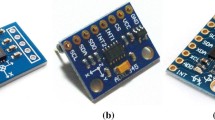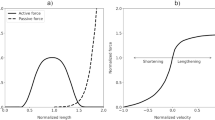Abstract
This paper develops the mathematical side of a theory of inactivations in human biomechanics. This theory has been validated by practical experiments, including zero-gravity experiments. The theory mostly relies on Pontryagin’s maximum principle on the one side and on transversality theory on the other side. It turns out that the periods of silence in the activation of muscles that are observed in practice during the motions of the arm can appear only if “something like the energy expenditure” is minimized. Conversely, minimization of a criterion taking into account the “energy expenditure” guaranties the presence of these periods of silence, for sufficiently short movements.
Similar content being viewed by others
References
W. Abend, E. Bizzi, and P. Morasso, “Human Arm Trajectory Formation,” Brain 105(Part 2), 331–348 (1982).
C. G. Atkeson and J. M. Hollerbach, “Kinematic Features of Unrestrained Vertical Arm Movements,” J. Neurosci. 5(9), 2318–2330 (1985).
S. Ben-Itzhak and A. Karniel, “Minimum Acceleration Criterion with Constraints Implies Bang-Bang Control as an Underlying Principle for Optimal Trajectories of Arm Reaching Movements,” Neural Comput. 20(3), 779–812 (2008).
N. Bernstein, The Co-ordination and Regulation of Movements (Pergamon Press, Oxford, 1967).
B. Berret, C. Darlot, F. Jean, T. Pozzo, C. Papaxanthis, and J.-P. Gauthier, “The Inactivation Principle: Mathematical Solutions Minimizing the Absolute Work and Biological Implications for the Planning of Arm Movements,” PLoS Comput. Biol. 4(10), e1000194 (2008).
B. Berret, J.-P. Gauthier, and C. Papaxanthis, “How Humans Control Arm Movements,” Tr. Mat. Inst. im. V.A. Steklova, Ross. Akad. Nauk 261, 47–60 (2008) [Proc. Steklov Inst. Math. 261, 44–58 (2008)].
J. J. Boessenkool, E. J. Nijhof, and C. J. Erkelens, “A Comparison of Curvatures of Left and Right Hand Movements in a Simple Pointing Task,” Exp. Brain Res. 120(3), 369–376 (1998).
B. Bonnard, “Invariants in the Feedback Classification of Nonlinear Systems,” in New Trends in Nonlinear Control Theory (Springer, Berlin, 1989), Lect. Notes Control Inf. Sci. 122, pp. 13–22.
S. Boyd, L. E. Ghaoui, E. Feron, and V. Balakrishnan, Linear Matrix Inequalities in System and Control Theory (SIAM, Philadelphia, PA, 1994), SIAM Stud. Appl. Math. 15.
F. H. Clarke, Optimization and Nonsmooth Analysis (J. Wiley and Sons, New York, 1983).
T. Flash and N. Hogan, “The Coordination of Arm Movements: An Experimentally Confirmed Mathematical Model,” J. Neurosci. 5(7), 1688–1703 (1985).
J.-P. Gauthier and I. Kupka, Deterministic Observation Theory and Applications (Cambridge Univ. Press, Cambridge, 2001).
J.-P. Gauthier and V. Zakalyukin, “On the One-Step-Bracket-Generating Motion Planning Problem,” J. Dyn. Control Syst. 11, 215–235 (2005).
R. Gentili, V. Cahouet, and C. Papaxanthis, “Motor Planning of Arm Movements Is Direction-Dependent in the Gravity Field,” Neuroscience 145(1), 20–32 (2007).
E. Guigon, P. Baraduc, and M. Desmurget, “Computational Motor Control: Redundancy and Invariance,” J. Neurophysiol. 97(1), 331–347 (2007).
M. Hallett and C. D. Marsden, “Ballistic Flexion Movements of the Human Thumb,” J. Physiol. 294, 33–50 (1979).
C. M. Harris and D. M. Wolpert, “Signal-Dependent Noise Determines Motor Planning,” Nature 394, 780–784 (1998).
F. Hermens and S. Gielen, “Posture-Based or Trajectory-Based Movement Planning: A Comparison of Direct and Indirect Pointing Movements,” Exp. Brain Res. 159(3), 340–348 (2004).
M. J. Hollerbach and T. Flash, “Dynamic Interactions between Limb Segments during Planar Arm Movement,” Biol. Cybern. 44(1), 67–77 (1982).
R. Kalman, “When Is a Linear Control System Optimal?,” Trans. ASME, Ser. D: J. Basic Eng. 86, 51–60 (1964).
E. B. Lee and L. Markus, Foundations of Optimal Control Theory (J. Wiley and Sons, New York, 1967).
P. Morasso, “Spatial Control of Arm Movements,” Exp. Brain Res. 42(2), 223–227 (1981).
A. Y. Ng and S. Russell, “Algorithms for Inverse Reinforcement Learning,” in Proc. 17th Int. Conf. on Machine Learning (Morgan Kaufmann Publ., San Francisco, CA, 2000), pp. 663–670.
J. Nishii and T. Murakami, “Energetic Optimality of Arm Trajectory,” in Proc. Int. Conf. on Biomechanics of Man (Charles Univ., Prague, 2002), pp. 30–33.
K. C. Nishikawa, S. T. Murray, and M. Flanders, “Do Arm Postures Vary with the Speed of Reaching?,” J. Neurophysiol. 81(5), 2582–2586 (1999).
C. Papaxanthis, T. Pozzo, and M. Schieppati, “Trajectories of Arm Pointing Movements on the Sagittal Plane Vary with both Direction and Speed,” Exp. Brain Res. 148(4), 498–503 (2003).
C. Papaxanthis, T. Pozzo, and P. Stapley, “Effects of Movement Direction upon Kinematic Characteristics of Vertical Arm Pointing Movements in Man,” Neurosci. Lett. 253(2), 103–106 (1998).
L. S. Pontryagin, V. G. Boltyanskii, R. V. Gamkrelidze, and E. F. Mishchenko, The Mathematical Theory of Optimal Processes (Fizmatgiz, Moscow, 1961; Pergamon Press, Oxford, 1964).
J. F. Soechting, “Effect of Target Size on Spatial and Temporal Characteristics of a Pointing Movement in Man,” Exp. Brain Res. 54(1), 121–132 (1984).
J. F. Soechting and F. Lacquaniti, “Invariant Characteristics of a Pointing Movement in Man,” J. Neurosci. 1(7), 710–720 (1981).
E. Todorov, “Optimal Control Theory,” in Bayesian Brain: Probabilistic Approaches to Neural Coding, Ed. by K. Doya et al. (MIT Press, Cambridge, MA, 2007), Ch. 12, pp. 269–298.
Y. Uno, M. Kawato, and R. Suzuki, “Formation and Control of Optimal Trajectory in Human Multijoint Arm Movement. Minimum Torque-Change Model,” Biol. Cybern. 61(2), 89–101 (1989).
Author information
Authors and Affiliations
Rights and permissions
About this article
Cite this article
Gauthier, JP., Berret, B. & Jean, F. A biomechanical inactivation principle. Proc. Steklov Inst. Math. 268, 93–116 (2010). https://doi.org/10.1134/S0081543810010098
Received:
Published:
Issue Date:
DOI: https://doi.org/10.1134/S0081543810010098




